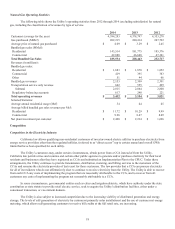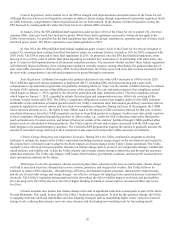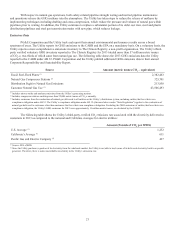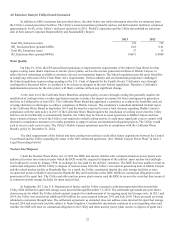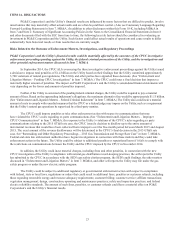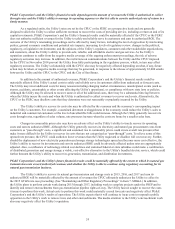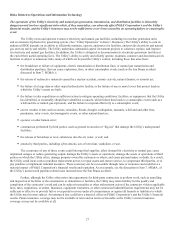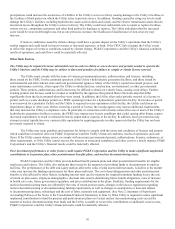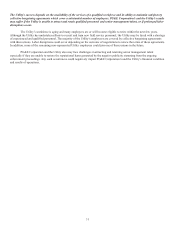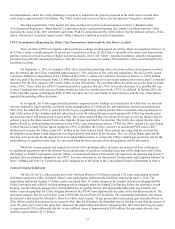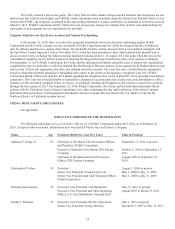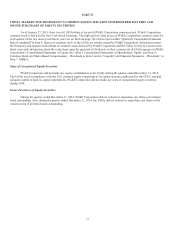PG&E 2014 Annual Report Download - page 36
Download and view the complete annual report
Please find page 36 of the 2014 PG&E annual report below. You can navigate through the pages in the report by either clicking on the pages listed below, or by using the keyword search tool below to find specific information within the annual report.28
The Utility’s operational and information technology systems could fail to function properly or be damaged by third parties
(including cyber-attacks and acts of terrorism), severe weather, natural disasters, or other events. Any of these events could
disrupt the Utility’s operations and cause the Utility to incur unanticipated losses and expense or liability to third parties.
The operation of the Utility’s extensive electricity and natural gas systems rely on evolving information and operational
technology systems and network infrastructures that are becoming more complex as new technologies and systems are
implemented to modernize capabilities to safely and reliably deliver gas and electric services. The Utility’s ability to serve its
customers requires the continued operation of complex information technology systems and network infrastructure that are
interconnected with the systems and infrastructure owned by third parties. The Utility’s business is highly dependent on its ability
to process and monitor, on a daily basis, a very large number of tasks and transactions, many of which are highly complex. Despite
implementation of security measures, all of the Utility’s technology systems are vulnerable to disability or failures due to hacking,
viruses, acts of war or terrorism and other causes. The failure of the Utility’s information and operational systems and networks
due to a physical attack, cyber-attack or other cause could significantly disrupt operations; cause harm to the public or employees;
result in outages or reduced generating output; damage the Utility’s assets or operations or those of third parties; and subject the
Utility to claims by customers or third parties, any of which could have a material effect on PG&E Corporation’s and the Utility’s
financial results.
The Utility’s systems, including its financial information, operational systems, advanced metering, and billing systems,
require ongoing maintenance, modification, and updating, which can be costly and increase the risk of errors and malfunction.
The Utility often relies on third-party vendors to maintain, modify, and update its systems and these third-party vendors could
cease to exist. Any disruptions or deficiencies in existing systems, or disruptions, delays or deficiencies in the modification
or implementation of new systems, could result in increased costs, the inability to track or collect revenues, the diversion of
management’s and employees’ attention and resources, and could negatively affect the effectiveness of the Utility’s control
environment, and/or the Utility’s ability to timely file required regulatory reports.
In addition, the Utility’s information systems contain confidential information, including information about customers and
employees. The theft, damage, or improper disclosure of confidential information can subject the Utility to penalties for violation
of applicable privacy laws, subject the Utility to claims from third parties, reduce the value of proprietary information, and harm
the Utility’s reputation.
The operation and decommissioning of the Utility’s nuclear power plants expose it to potentially significant liabilities and the
Utility may not be able to fully recover its costs if regulatory requirements change or the plant ceases operations before the
licenses expire.
The operation of the Utility’s nuclear generation facilities exposes it to potentially significant liabilities from
environmental, health and financial risks, such as risks relating to the storage, handling and disposal of spent nuclear fuel, the
release of radioactive materials caused by a nuclear accident, seismic activity, natural disaster, or terrorist act. The operation of the
nuclear facilities also depends on the availability of adequate fuel supplies. If the Utility incurs losses that are either not covered
by insurance or exceed the amount of insurance available, such losses could have a material effect on PG&E Corporation’s and the
Utility’s financial results. In addition, the Utility may be required under federal law to pay up to $255 million of liabilities arising
out of each nuclear incident occurring not only at the Utility’s Diablo Canyon facility but at any other nuclear power plant in the
United States. (See Note 14 of the Notes to the Consolidated Financial Statements in Item 8.)
In addition, the Utility continues to face public concern about the safety of nuclear generation and nuclear fuel. Some
of these nuclear opposition groups regularly file petitions at the NRC and in other forums challenging the actions of the NRC
and urging governmental entities to adopt laws or policies in opposition to nuclear power. Although an action in opposition may
ultimately fail, regulatory proceedings may take longer to conclude and be more costly to complete. It is also possible that public
pressure could grow and that future changes in legislation, regulations, orders, or their interpretation, could result in the Utility
ceasing operations at Diablo Canyon before the licenses expire. In such an instance, the Utility could be required to record a charge
for the remaining amount of its unrecovered investment and such charge could have a material effect on PG&E Corporation and
the Utility’s financial results.
The Utility has incurred, and may continue to incur, substantial costs to comply with NRC regulations and orders. (See
“Regulatory Environment” in Item 1. Business.) If the Utility were unable to recover these costs, PG&E Corporation’s and the
Utility’s financial results could be materially affected. The Utility may determine that it cannot comply with the new regulations
or orders in a feasible and economic manner and voluntarily cease operations; alternatively, the NRC may order the Utility to
cease operations until it can comply with new regulations, orders, or decisions. The Utility may incur a material charge if it ceases
operations at Diablo Canyon before the licenses expire.


